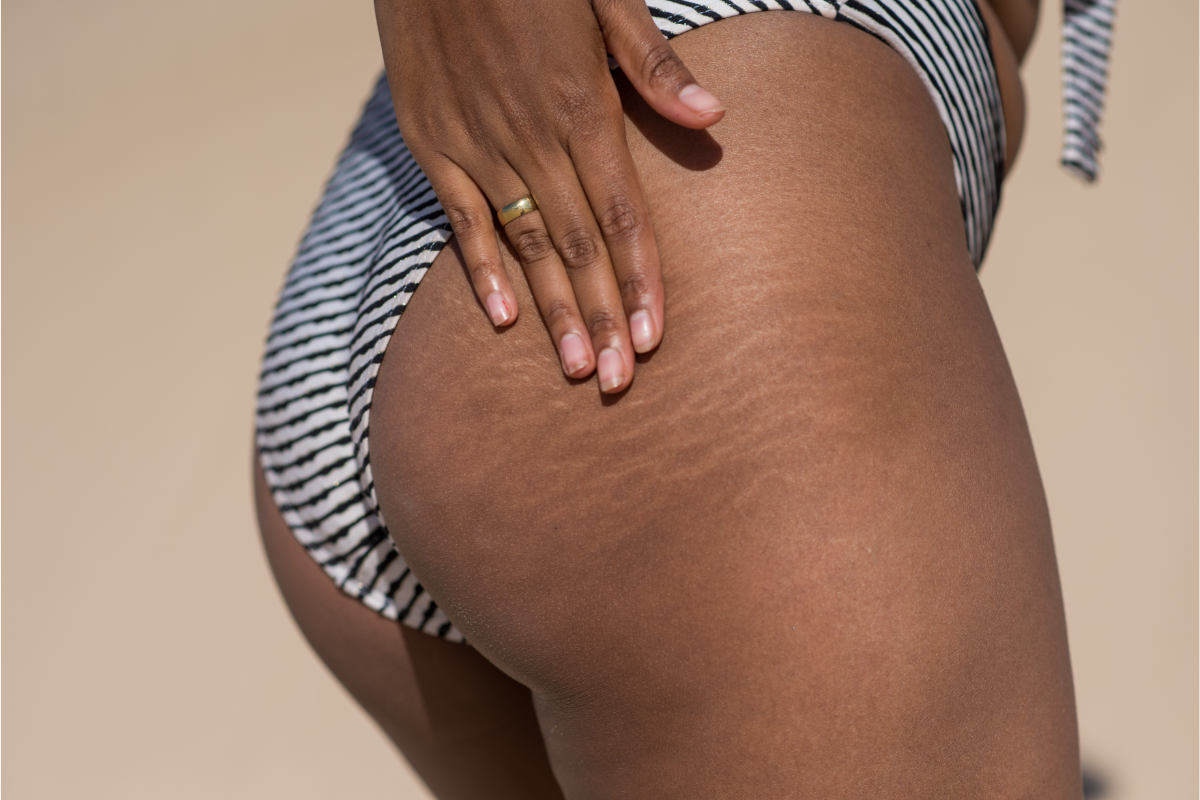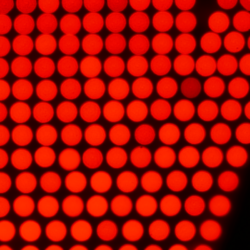In this article, we’ll explore the different types of stretch marks, including Striae Rubrae, Striae Albae, and Striae Gravidarum, as well as looking at the factors that encourage their appearance, such as Cushing’s syndrome or genetic factors. In addition, we will discuss various approaches to prevention and treatment, ranging from natural care to more advanced medical options. Our aim is to provide an in-depth understanding of stretch marks and effective strategies for managing them.
What is a stretch mark?
Stretch marks, or “striae distensae”, are dermal lesions in the form of linear bands. They are the result of a break in the skin’s elastic and collagen fibres, often due to rapid stretching. This leads to a kind of atrophic scar where the skin loses its normal capacity for tension and elasticity.
Stretch marks are small striations on the stomach, thighs and breasts, resulting from excessive stretching of the skin and rupture of the elastic fibres in the dermis. They generally appear on people who are obese and on women who have had one or more pregnancies.
The appearance of stretch marks during pregnancy is a significant, even traumatic event for women, especially as they are not considered a medical priority.
Stretch marks are areas of skin where the deep dermis, located between the epidermis and hypodermis, has spontaneously torn. When they first appear, they take the form of streaks resembling long scars, are purplish-red in colour and are inflammatory. They lighten over time to become white and pearly, almost the same colour as the skin.
What are the different types of stretch marks?
Striae Rubrae
Striae rubrae are the first stage of stretch marks. They generally appear as red or purple lines, indicating the initial phase of stretch mark formation. This colouration is due to inflammation and the increased presence of blood vessels in the affected area. These stretch marks are often slightly raised in relation to the surrounding skin and can cause an itching sensation. This phase is considered the most reactive to treatment, as the tissues are not yet completely healed.
Striae Albae
Over time, Striae Rubrae develop into Striae Albae. This stage is characterised by white or silver stripes which are flatter and less visible than Striae Rubrae. This colour transition indicates a reduction in inflammation and blood vessels in the area. Striae Albae represent a more mature stage of stretch marks where scar tissue has formed and the skin has lost some of its natural elasticity. At this stage, stretch marks are generally less sensitive to treatment due to the breakdown of collagen and elastin fibres.
Striae Gravidarum
Striae Gravidarum are specific to pregnancy. These stretch marks often form around the abdomen, but can also appear on the breasts, thighs and other areas subject to rapid stretching during pregnancy. The prevalence of Striae Gravidarum is high due to the rapid expansion of the abdomen and hormonal fluctuations that weaken the collagen fibres in the skin. These stretch marks may begin as Striae Rubrae before becoming Striae Albae after childbirth.
Stretch marks caused by Cushing’s syndrome:
This condition known as Cushing’s syndrome is the cause of significant stretch marks. These stretch marks are typically large, red, vertical and located on the abdomen, the roots of the thighs, the arms and the breasts.
Cushing’s disease is one form of Cushing’s syndrome. This is due to the production of too much cortisol, the excess of which in the body is responsible for the various symptoms observed. This is known as hypercorticism.
The symptoms of Cushing’s syndrome disappear within a few months of the hypersecretion of cortisol ceasing. Scars from stretch marks and vertebral compression caused by osteoporosis may remain.
Why do I have stretch marks?
Stretch marks can appear for a variety of reasons:
- Rapid growth: Common during adolescence or when muscle mass is rapidly gained, particularly by bodybuilders.
- Pregnancy: Hormonal changes and stretching of the skin around the abdomen during pregnancy can cause stretch marks.
- Weight variations: Rapid weight gain or loss can stretch the skin and create stretch marks.
- Use of corticosteroids: Prolonged use of these drugs can reduce the collagen in the skin, making stretch marks more likely to appear.
- Genetic factors and diseases: Certain disorders, such as Marfan’s or Cushing’s syndrome, can influence the development of stretch marks.
Some naturopathic advice to prevent stretch marks
Drink plenty of water:
Water is necessary to cleanse your body and strengthen your cells. What’s more, it’s only by drinking enough fluids that you can maintain your skin’s moisture content.
Avoid rapid weight gain:
Sudden weight gain (followed by weight loss) naturally puts extreme stress on the skin, and encourages the formation of stretch marks. During your pregnancy, try to eat enough, but be careful not to double up. Remain aware of your feelings of satiety (as opposed to gluttony). It’s best to gain weight gradually and regularly.
Moisturise and massage your skin:
Ideally, concentrate daily on massaging areas prone to stretch marks, such as the stomach, buttocks, hips and legs. Opt for a nourishing massage oil, rich in essential fatty acids, which will improve the skin’s elasticity. And don’t forget dry brushing!
Take collagen:
Studies have shown that supplementing with hydrolysed collagen could have beneficial effects on skin health, including improving hydration, elasticity and reducing the appearance of wrinkles. This suggests that collagen could potentially help strengthen the skin and thus help prevent the appearance of stretch marks. A systematic review and meta-analysis of clinical trials revealed favourable results of hydrolysed collagen supplementation compared with placebo in terms of skin hydration, elasticity and wrinkles.
Protect your skin from the sun:
If you stay in the sun for a long time, stretch marks are likely to be even more visible. Remember to protect your skin with a suitable sunscreen.
What natural plant-based treatments can I use to take care of my stretch marks?
Macadamia oil:
Macadamia oil is well absorbed by the skin, while allowing for prolonged massage. It facilitates local microcirculation (by toning lymphatic circulation), protects cells and nourishes and softens the skin. Recommended for fragile skin, stretch marks and scars.
Argan oil:
Argan oil is a rejuvenating hydration cure for dry skin and skin ageing (unsaponifiable).
Rich in oleic linoleic fats, it contains around 80% unsaturated fatty acids. It plays a role in the permeability of the epidermis and protects against dry skin and stretch marks in pregnant women.
Rich in vitamin E, it stimulates enzymatic activity linked to detoxification and antioxidant defence of the cells, resulting in a reduction in membrane susceptibility to peroxidation.
Ladaniferous rockrose essential oil:
This essential oil is often used in preparations to combat skin ageing, wrinkles and stretch marks due to its astringent and skin toning properties.
Horsetail :
We like to use this plant in cosmetology as part of the prevention of wrinkles, stretch marks and cellulite. Remineralising thanks to the silica it contains, it improves the resistance of connective tissue and is a healing agent(organosoluble silicon). Use on the skin after infusion with soaked compresses.
Centella asiatica :
Centella asiatica, also known as Gotu Kola, is a traditional medicinal plant often used in the treatment of stretch marks. Its restorative and anti-inflammatory properties are widely recognised in various medicinal and cosmetic applications.
Effectiveness of Centella asiatica in the treatment of stretch marks
Studies have shown that Centella asiatica may play a significant role in improving the appearance of stretch marks. For example, a pilot study evaluated the efficacy of a topical cream containing a standardised extract of Centella asiatica (CAST, Indena S.p.A., Milan, Italy) used after pregnancy to restore normal skin elasticity in stretch marks and improve local microcirculation. This study observed a significant improvement in the appearance of stretch marks in participants after 4 to 6 weeks’ application of the cream.
Oral supplementation with Centella asiatica
In addition to topical application, research has also examined the effect of oral supplementation with Centella asiatica on stretch marks. A study published on PubMed indicated that oral supplementation with Centellicum®, a preparation of Centella asiatica, appeared to improve stretch marks in a relatively short period of time. These results suggest that Centella asiatica may offer both preventive and reparative benefits in terms of stretch mark management.
Mode of action of Centella asiatica
Centella asiatica promotes wound healing and the scarring process by stimulating the production of type I collagen and controlling inflammation and the production of myofibroblasts. Its extracts are considered to be standard pharmaceutical ingredients, useful in a number of applications to improve damage to the vein wall and act on connective tissue.
Which non-prescription active ingredients should I use to reduce the appearance of stretch marks?
Is retinol effective in removing stretch marks?
Retinol, a form of vitamin A, is often cited for its beneficial properties on the skin, particularly in the treatment of stretch marks. It works by stimulating collagen production, which can help to improve the appearance of stretch marks.
Retinol’s mechanism of action on stretch marks
Retinol stimulates the production of new skin cells and increases the production of collagen, an essential component of skin structure. This increase in collagen can help make stretch marks less visible by improving the skin’s elasticity and texture.
Proven effectiveness in studies
Several studies have demonstrated the effectiveness of retinol in reducing the appearance of stretch marks. For example, a study published in the Journal of the American Academy of Dermatology found that topical use of retinol on recent stretch marks significantly improved their appearance. It is important to note that results may vary depending on the age of the stretch marks and skin type.
Can hyaluronic acid improve the appearance of stretch marks?
Hyaluronic acid, a compound naturally present in the body, is renowned for its moisturising and skin-regenerating properties. Its effectiveness in the treatment of stretch marks is being increasingly studied and understood.
Mechanism of action of hyaluronic acid
Hyaluronic acid works by increasing skin hydration, which can help improve elasticity and texture. It contributes to the regeneration of the dermis by promoting the production of collagen, a key element in the repair of damaged skin tissue, as is the case with stretch marks.
Proven effectiveness in studies
Studies have shown that products containing hyaluronic acid can be beneficial in reducing the appearance of stretch marks. For example, research published in the Journal of the European Academy of Dermatology and Venereology examined the effects of different topical treatments on stretch marks, highlighting the potential effectiveness of hyaluronic acid. These studies suggest that hyaluronic acid may be particularly effective on recent stretch marks in the healing phase.
Is glycolic acid effective in removing stretch marks?
Glycolic acid, a type of alpha hydroxy acid (AHA), is commonly used in skin care products for its exfoliating properties. Its potential role in the treatment of stretch marks has aroused the interest of the dermatological community.
Mechanism of action of glycolic acid
Glycolic acid works by exfoliating the top layer of skin, which promotes cellregeneration and can help improve the appearance of stretch marks. By removing dead skin cells, it promotes the emergence of new, smoother, more even skin. In addition, glycolic acid stimulates the production of collagen and elastin, two key components for skin firmness and elasticity.
Effective in treating stretch marks
Although glycolic acid is often used to treat various skin problems, such as acne and skin ageing, its effectiveness in treating stretch marks is the subject of debate. Some studies have shown improvements in the appearance of stretch marks, particularly when used in combination with other treatments, such as retinol-based creams or laser therapy.
Sources
- Stretch Marks- Amanda M. Oakley; Bhupendra C. Patel. Author Information and Affiliations Last Update: August 7, 2023.
- Int J Dermatol. 2021 Dec;60(12):1449-1461. doi: 10.1111/ijd.15518. Epub 2021 Mar 20.
Effects of hydrolyzed collagen supplementation on skin aging: a systematic review and meta-analysis - Minerva Ginecol. 2018 Oct;70(5):629-634. doi: 10.23736/S0026-4784.18.04254-5.
Postpartum stretchmarks: repairing activity of an oral Centella asiatica supplementation (Centellicum®)





